CADILLAC SEVILLE 1997 4.G Owners Manual
Manufacturer: CADILLAC, Model Year: 1997, Model line: SEVILLE, Model: CADILLAC SEVILLE 1997 4.GPages: 370, PDF Size: 20.52 MB
Page 271 of 370
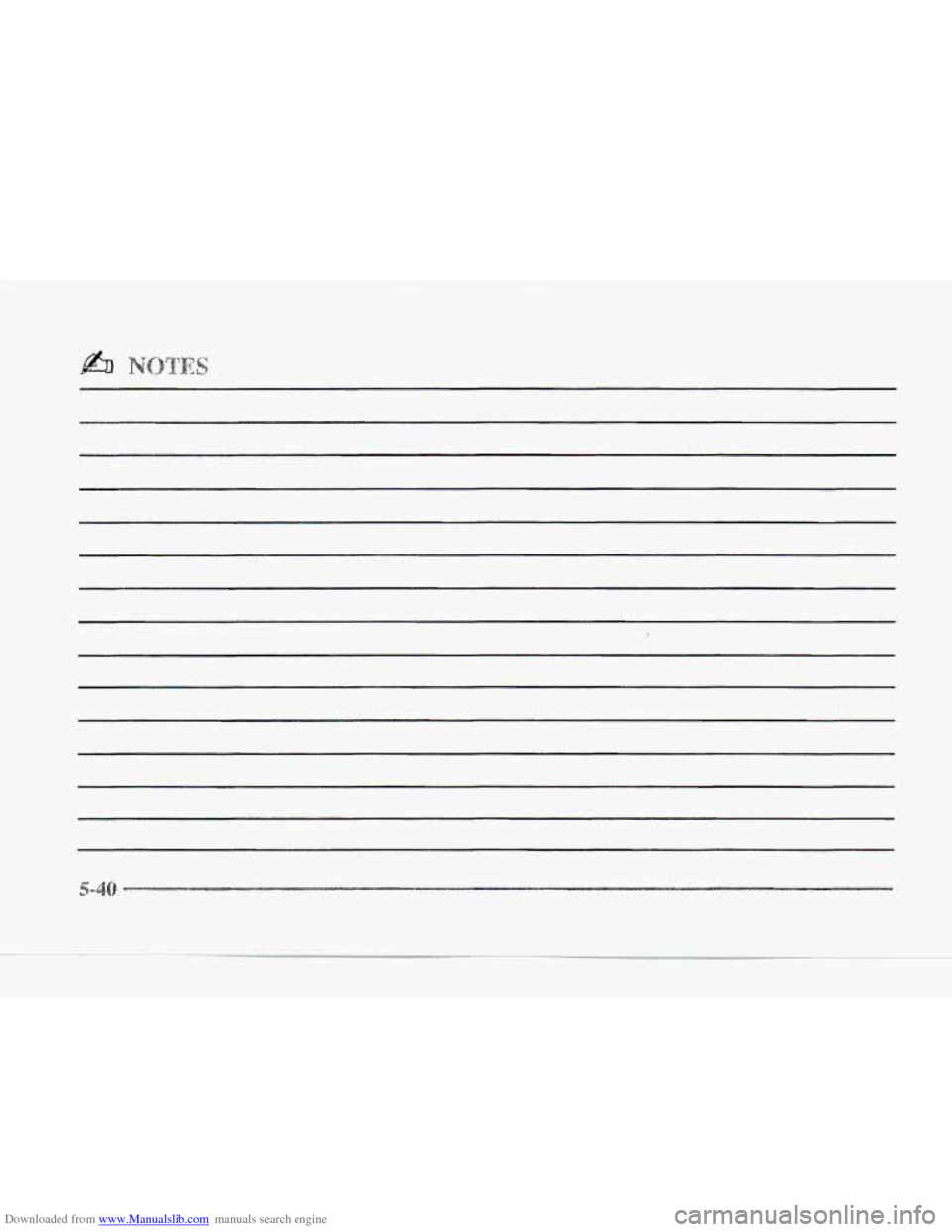
Downloaded from www.Manualslib.com manuals search engine
Page 272 of 370
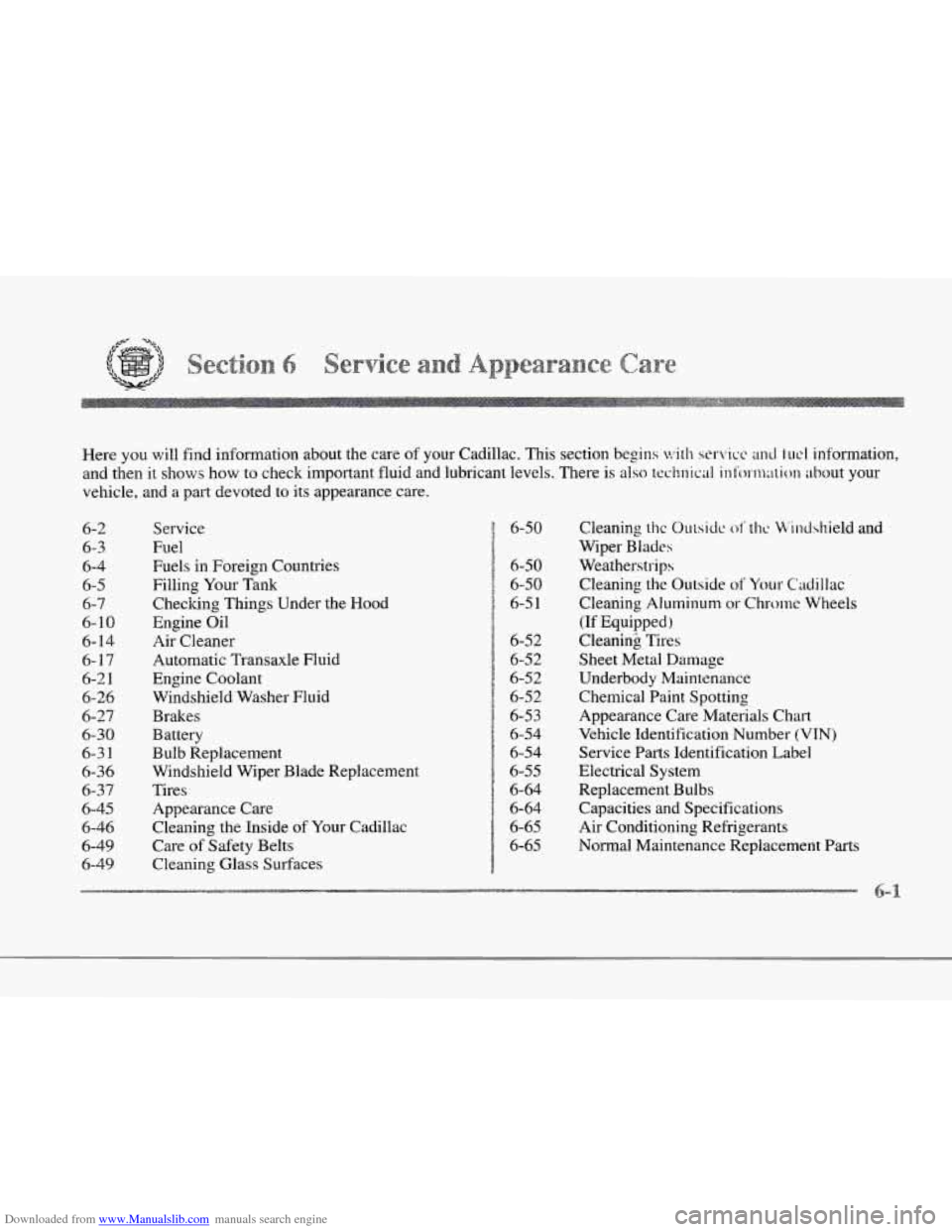
Downloaded from www.Manualslib.com manuals search engine r
r
r
r
r
r
r
Here you will find information about the care of your Cadillac. This section begins with servicc and fucl information,
and then it shows how to check important fluid and lubricant levels. There is also
technical in1i)m;ttion about your
vehicle, and
a part devoted to its appearance care.
6-2
6-3
6-4
6-5
6-7
6-1
0
6- 14
6-17
6-2
I
6-26
6-27
6-30
6-3
1
6-36
6-37
6-45
6-46
6-49 6-49
Se.rvice
Fuel
Fuels in Foreign Countries
Filling Your Tank
Checking Things Under the Hood
Engine Oil
Ais Cleaner
Automatic Transaxle Fluid
Engine Coolant
Windshield Washer Fluid
Brakes
Battery Bulb Replacement
Windshield Wiper Blade Replacement
Tires
Appearance Care
Cleaning the Inside
of Your Cadillac
Care
of Safety Belts
Cleaning Glass Surfaces
6-50
6-50
6-50
6-5 1
6-52
6-5
2
6-52
6-52
6-5 3
6-54 6-54
6-55 6-64
6-64
6-65
6-65
Cleaning thc Oulside of thc b’indshield and
Wiper Blades
Weatherstrips Cleaning the Outside
of Your Cadillac
Cleaning Aluminum or
Chrome Wheels
(If Equipped)
Cleanink Tires
Sheet Metal Damage
Underbody Maintenance
Chemical Paint Spotting
Appearance Care Materials Chart
Vehicle Identification Number
(VIN)
Service Parts Identification Label
Electrical System Replacement Bulbs Capacities and Specifications
Air Conditioning Refrigerants
Normal Maintenance Replacement
Parts
Page 273 of 370
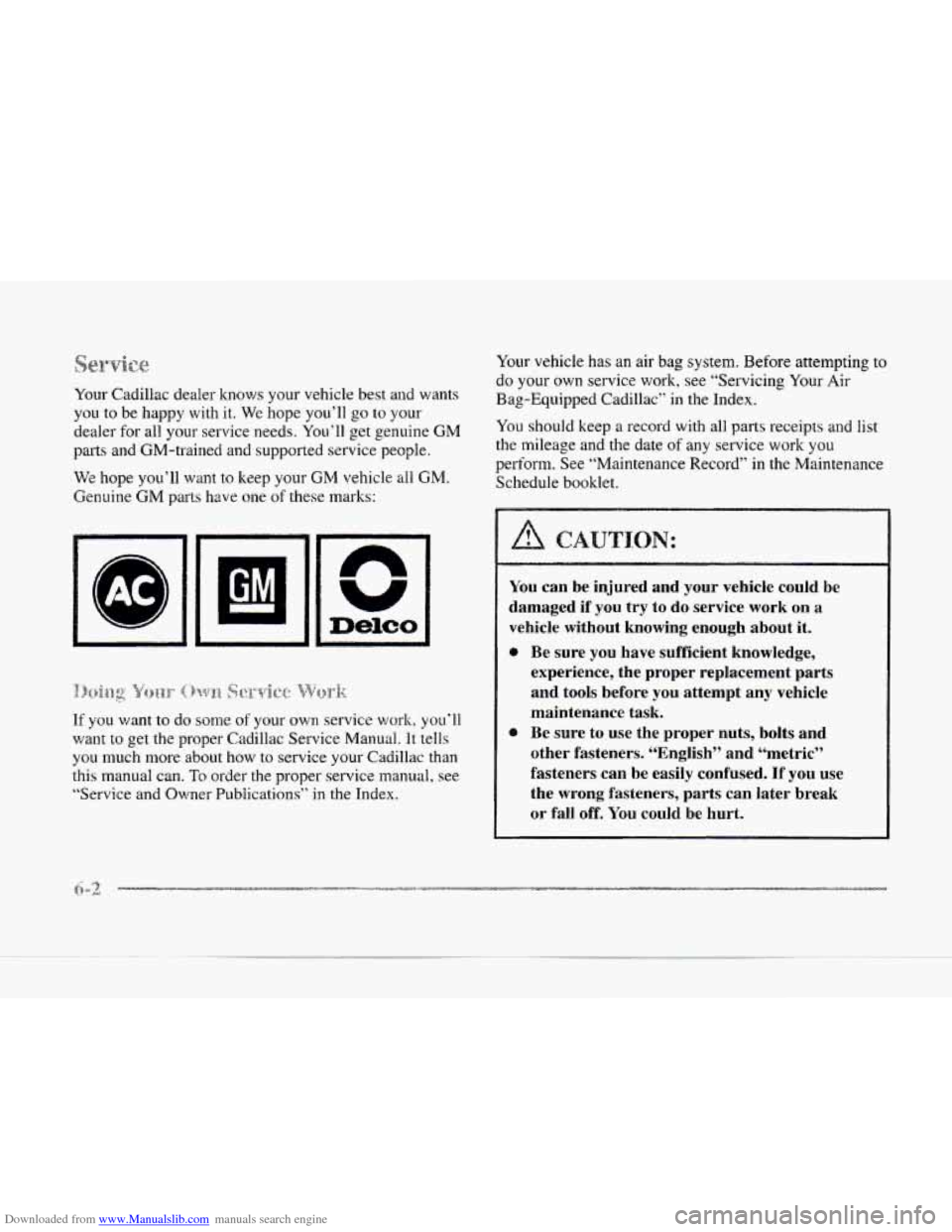
Downloaded from www.Manualslib.com manuals search engine Your vehicle has an air bag system. Before attempting to
do
your own service work, see “Servicing Your Air
Your Cadillac dealer
knows your vehicle best and Wants Bag-Equipped Cadillac” in the Index.
you to be happy with it. We hope
you’ll go to your
dealer for all your service needs. You’ll get genuine GM You should keep
a record with all parts receipts and list
the mileage and the date
of any service work you
perform. See “Maintenance Record” in the Maintenance
parts
and GM-trained and supported service people.
We hope you’ll
want to keep your GM vehicle all GM.
Genuine GM parts have one of these marks:
--
If you want to do some of your own service work, you’ll
want to get the proper Cadillac Service Manual. It tells
you much more about how to service your Cadillac than
this manual can.
To order the proper service manual, see
“Service and Owner Publications” in the Index. Schedule
booklet.
CAUTION:
You can be injured and your vehicle could be
damaged if you try
to do service work on a
vehicle without knowing enough about it.
Be sure you have sufficient knowledge,
experience, the proper replacement parts
and tools before you attempt any vehicle
maintenance task.
Be sure to use the proper nuts, bolts and
other fasteners. “English” and “metric”
fasteners can be easily confused.
If you use
the wrong fasteners, parts can later break
or
fall off. You could be hurt.
Page 274 of 370
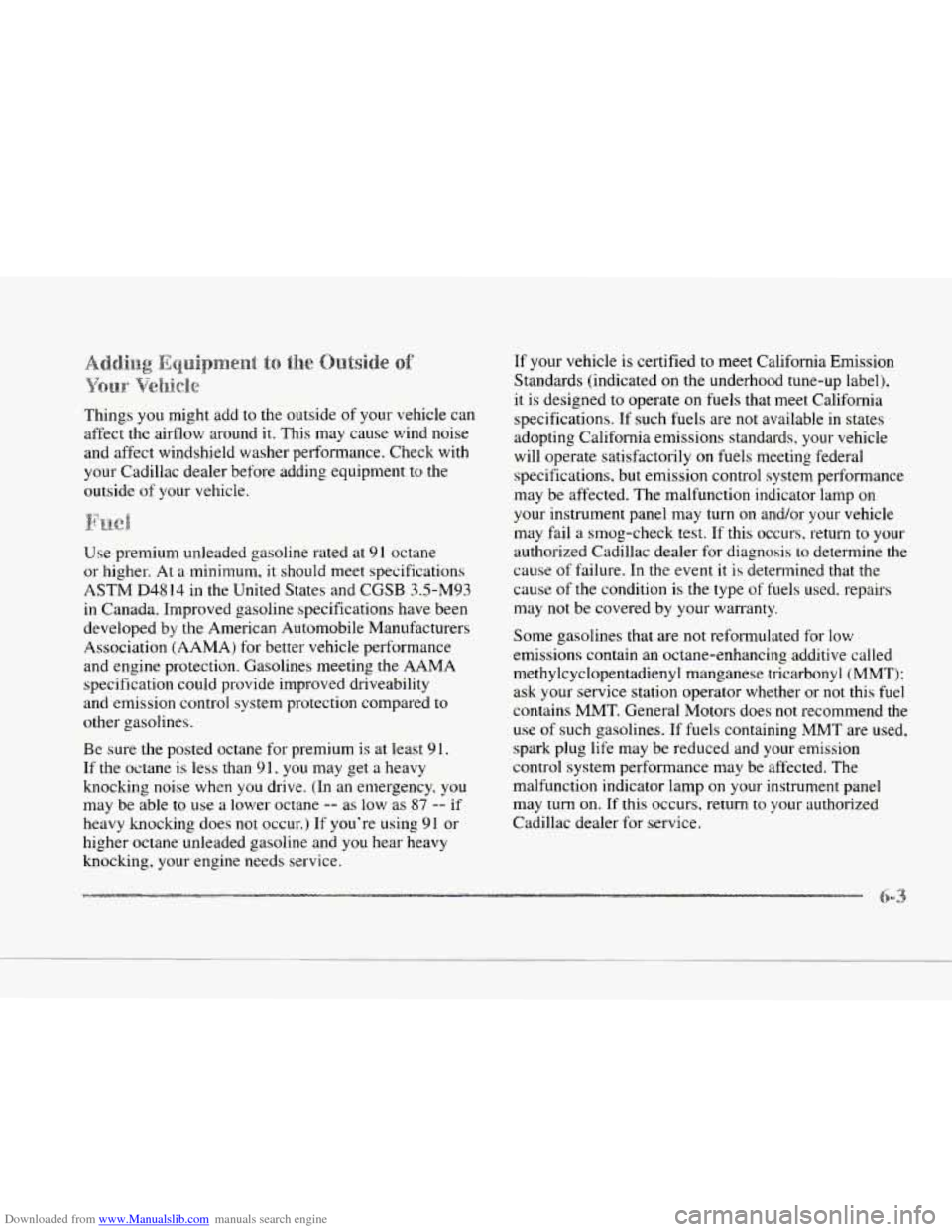
Downloaded from www.Manualslib.com manuals search engine c
c
c
Things you might add to the outside of your vehicle can
affect the airflow around it. This may cause wind noise
and affect windshield washer performance. Check with
your Cadillac dealer before adding equipment
to the
outside
of your vehicle.
Use premium unleaded gasoline rated at 91 octane
or higher. At a minimum,
it should meet specifications
ASTM D48 14 in the United States and CGSB 3.5-M93
in Canada. Improved gasoline specifications have been
developed by the American Automobile Manufacturers
Association (AAMA) for better vehicle performance
and engine protection. Gasolines meeting
the AAMA
specification could provide improved driveability
and emission control system protection compared to
other gasolines.
Be sure the posted octane for premium
is at least 91.
If the octane is less than 9 1, you may get a heavy
knocking noise when
you drive. (In an emergency. you
may be able
to use a lower octane -- as low as 87 -- if
heavy knocking does not occur.) If you’re using
91 or
higher octane unleaded gasoline and
you hear heavy
knocking, your engine needs service. If
your vehicle is certified to meet California Emission
Standards (indicated on the underhood tune-up label),
it is designed to operate
on fuels that meet California
specifications. If such fuels are not available in states
adopting California emissions standards, your vehicle
will operate satisfactorily
on fuels meeting federal
specifications, but emission control system performance
may be affected. The malfunction indicator lamp on
your instrument panel may turn
on and/or your vehicle
may fail
a smog-check test. If this occurs, return to your
authorized Cadillac dealer for diagnosis to determine the
cause
of failure. In the event it is determined that the
cause
of the condition is the type of fuels used. repairs
may not be covered by your wan-anty.
Some gasolines that are
not reformulated for low
emissions contain an octane-enhancing additive called
methylcyclopentadienyl manganese tricarbonyl
(MMT):
ask your service station operator whether or not this fuel
contains MMT. General Motors does not recommend the
use of such gasolines. If fuels containing MMT are used.
spark plug life may be reduced and your emission
control system performance may be affected. The
malfunction indicator lamp on your instrument panel
may
turn on. If this occurs, return to your authorized
Cadillac dealer for service.
Page 275 of 370
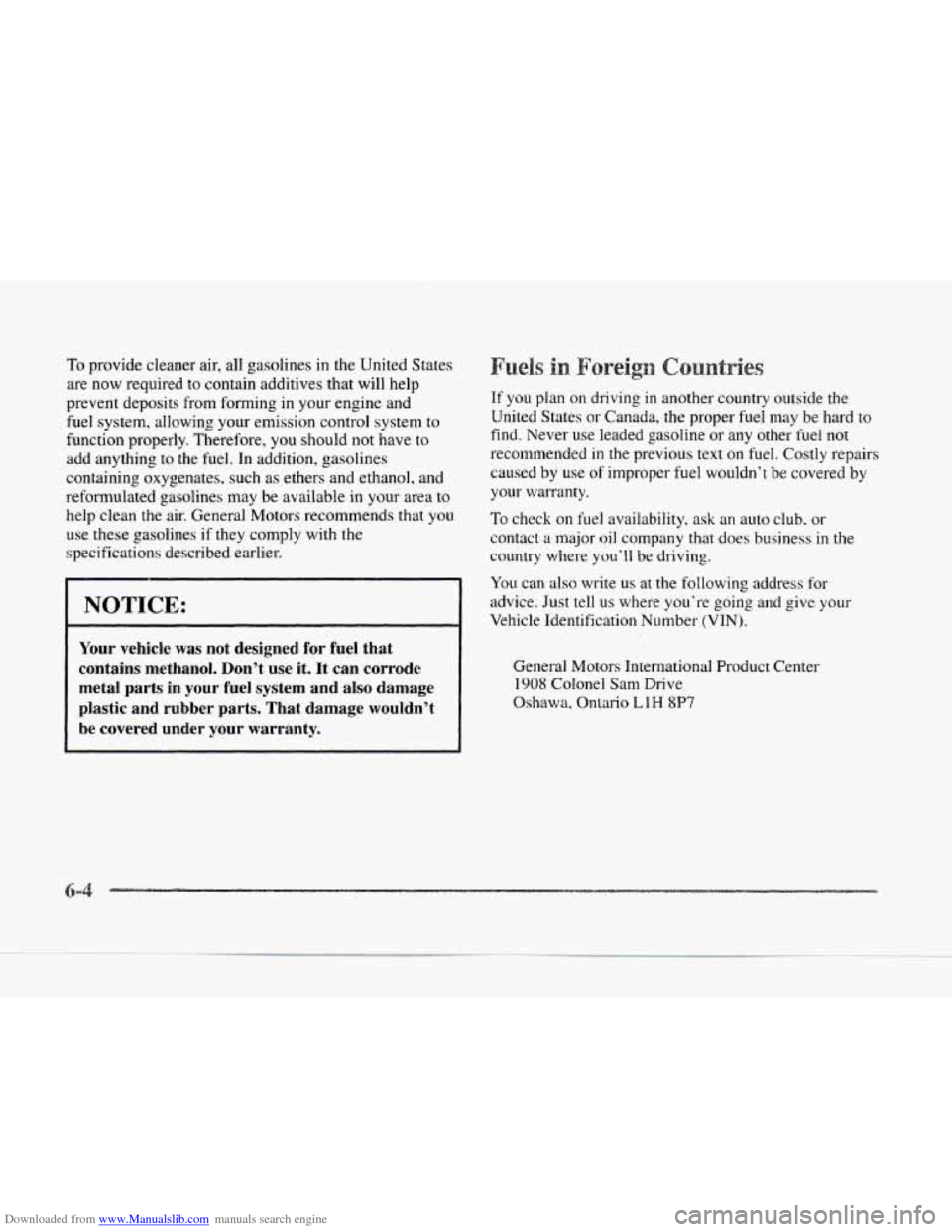
Downloaded from www.Manualslib.com manuals search engine To provide cleaner air, all gasolines in the United States
are now required
to contain additives that will help
prevent deposits
from forming in your engine and
fuel system, allowing your emission control system to
function properly. Therefore,
you should not have to
add anything to the fuel. In addition, gasolines
containing oxygenates, such as ethers and ethanol, and
reformulated gasolines may be available
in your area to
help clean the air. General Motors recommends that you
use these gasolines
if they comply with the
specifications described earlier.
NOTICE:
Your vehicle was not designed for fuel that
contains methanol. Don’t use
it. It can corrode
metal parts in your
fuel system and also damage
plastic and rubber parts. That damage wouldn’t
be covered under your warranty.
If you plan on driving in another country outside the
United States or Canada, the proper fueI may be hard
to
find. Never use leaded gasoline or any other fuel not
recommended
in the previous text on fuel. Costly repairs
caused by use
of improper fuel wouldn’t be covered by
your warranty.
To check on fuel availability, ask an auto club. or
contact
a major oil company that does business in the
country where
you‘ll be driving.
You can also write
us at the following address for
advice. Just tell us where you’re going and give your
Vehicle Identification Number (VIN).
General Motors International Product Center
1908 Colonel Sam Drive
Oshawa, Ontario
LlH 8P7
Page 276 of 370
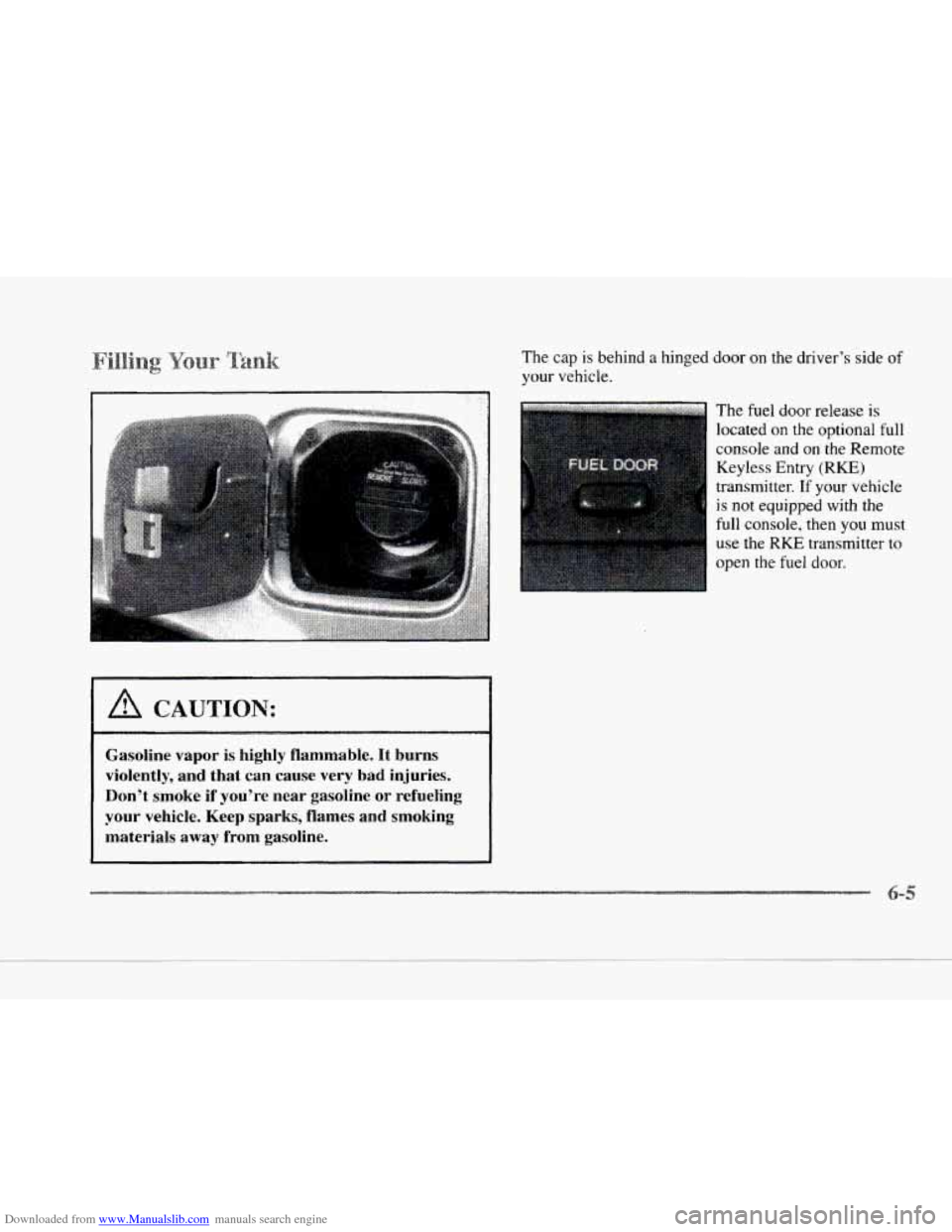
Downloaded from www.Manualslib.com manuals search engine . ..
Gasoline vapor is highly flammable. It burns
violently, and that can cause very bad injuries.
Don’t smoke
if you’re near gasoline or refueling
your vehicle. Keep sparks, flames and smoking
materials away from gasoline.
The cap is behind a hinged door on the driver’s side of
your vehicle.
located
on the optional full
console and on the Remote
Keyless Entry
(RISE)
transmitter. If your vehicle
is
not equipped with the
full console, then you must
use the RKE transmitter to
open the fuel door.
Page 277 of 370
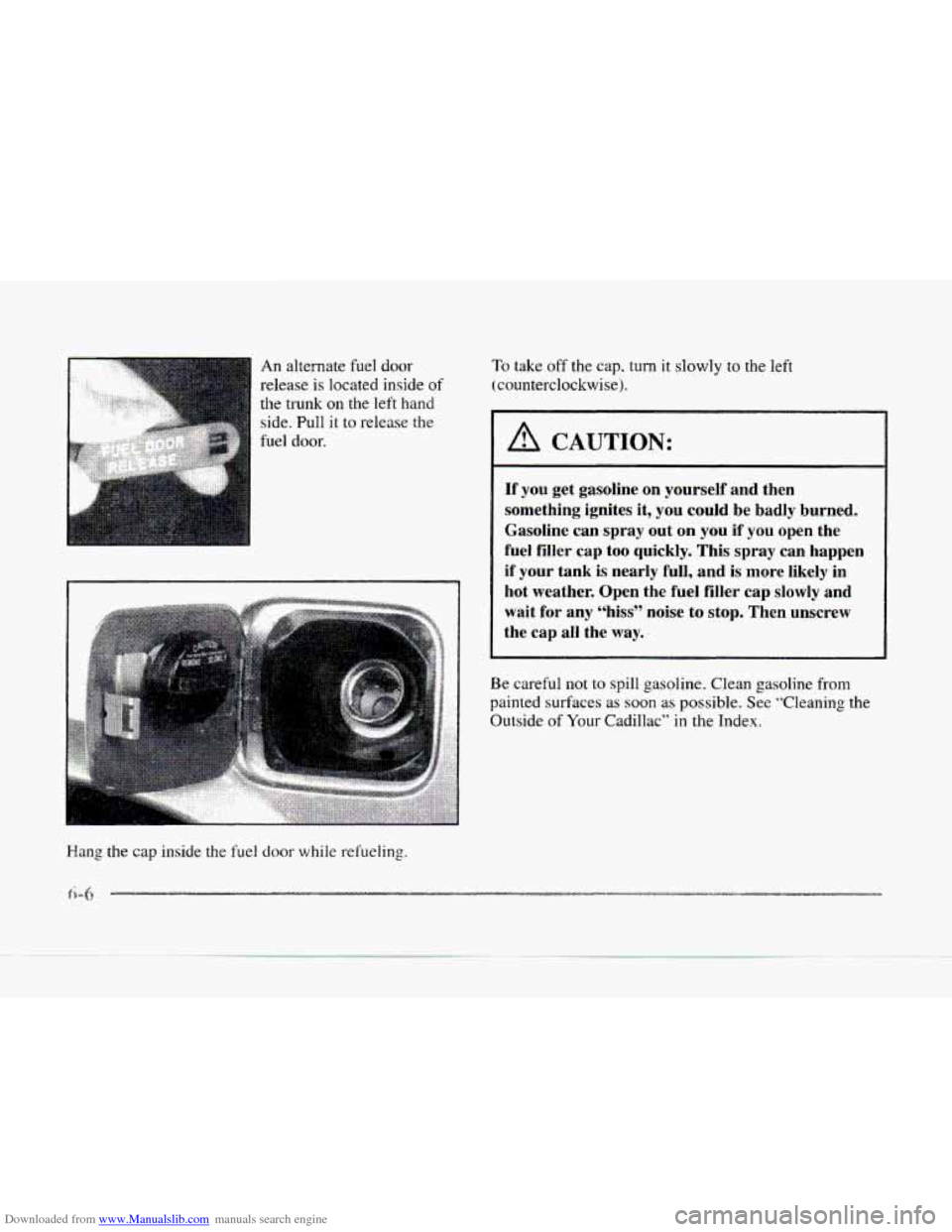
Downloaded from www.Manualslib.com manuals search engine An alternate fuel door
release is located inside of
the trunk on the left hand
side.
Pull it to release the
fuel door.
To take off the cap, turn it slowly to the left
(counterclockwise).
I A CAUTION:
If you get gasoline on yourself and then
something ignites it, you could be badly burned.
Gasoline can spray out
on you if you open the
fuel filler cap too quickly. This spray can happen
if your tank is nearly full, and
is more likely in
hot weather. Open the fuel filler cap slowly and
wait for any “hiss” noise
to stop. Then unscrew
the cap
all the way.
Be careful
not to spill gasoline. Clean gasoline from
painted surfaces as soon
as possible. See “Cleaning the
Outside
of Your Cadillac” in the Index.
Hang the cap inside the
fuel door while refueling.
--
I
Page 278 of 370
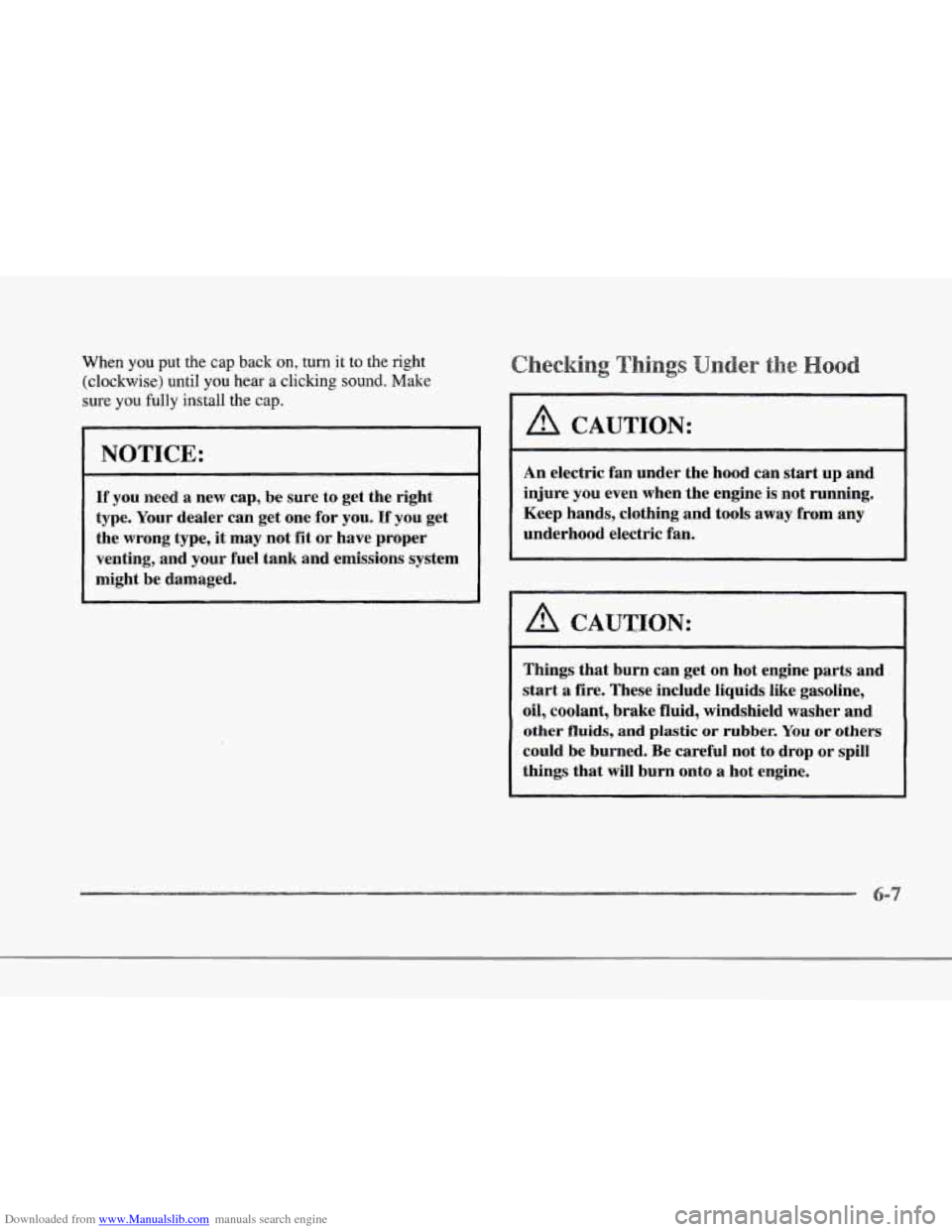
Downloaded from www.Manualslib.com manuals search engine r
f
When you put the cap back on, turn it to the right
(clockwise) until you hear a clicking sound. Make
sure
you fully install the cap.
If you need a new cap, be sure to get the right
type. Your dealer can get one for you.
If you get
the wrong type, it may not
fit or have proper
venting, and your fuel tank and emissions system
might be damaged.
r
r
r
r
IP
A CAUTION:
An electric fan under the hood can start up and
injure you even when the engine is not running.
Keep hands, clothing and tools away from any
underhood electric fan.
A CAUTION:
Things that burn can get on hot engine parts and
start a fire. These include liquids like gasoline,
oil, coolant, brake fluid, windshield washer and
other fluids, and plastic or rubber. You or others
could be burned. Be careful not to drop
or spill
things that will burn onto a hot engine.
Page 279 of 370

Downloaded from www.Manualslib.com manuals search engine Pull the lever inside the
vehicle
to open the hood. It
is located
on the lower left
side of the instrument panel.
R
Then go to the front of the vehicle and find the
secondary hood release which
is located above the front
grille. Lift
up on the release lever as you raise the hood.
Page 280 of 370
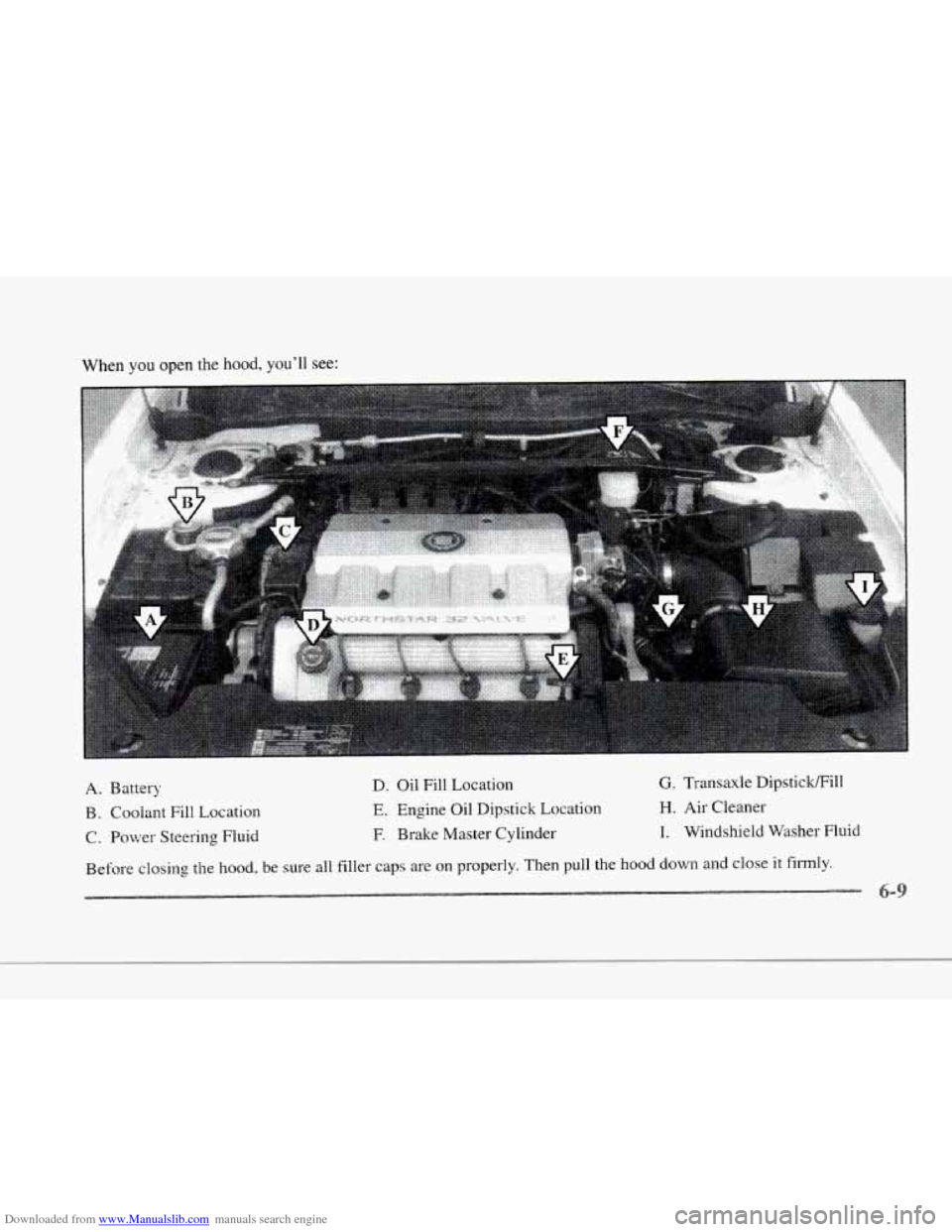
Downloaded from www.Manualslib.com manuals search engine F
U
r
r
When you open the hood, you'll see:
A. Battery
B. Coolant
Fill Location
C. Power Steering Fluid D.
Oil Fill Location E. Engine Oil Dipstick Location
E Brake Master Cylinder
G. Transaxle DipstickEill
H. Air Cleaner
I. Windshield Washer Fluid
Before closing the hood,
be sure all filler caps are on properly. Then pull the hood down and close it firmly.